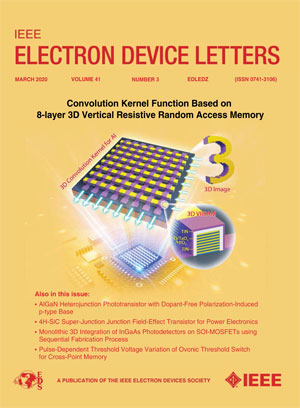一种简单的非掺杂供体/受体四元激子复合物体系提高三重激子利用率
IF 4.1
2区 工程技术
Q2 ENGINEERING, ELECTRICAL & ELECTRONIC
引用次数: 0
摘要
该界面异构体不需要精确的掺杂工艺,具有比传统荧光发射器更高的效率。三重态激子的利用已被确定为在这种系统中实现高效发光的关键因素。通过在界面激子复合物之间插入超薄层,可以构建一个简单的界面结构,并与传统的输运材料结合,便于激子的利用和能量的传递。该策略不需要精确的掺杂过程和荧光客体在界面处形成四元异构体,以构建异构体之间的能量传递。优化后的四元激元器件实现了13.4%的外量子效率(EQE)和34.3 cd/ a的电流效率(CE),超过了单个激元器件的性能。光致发光量子产率(PLQYs)从28.7%提高到52.7%,反向系统间交叉(RISC)率从$ 100提高到$ 100。{5}\乘以{10}^{{5}}$到${2}。{10}{2} \倍^ {{5}~}$ $ {\ mathrm{年代}}^{-{1}}$后插入超薄层。这些改进归功于多个能量传递和RISC通道的存在,这些通道加速了单重态激子的消耗,并促进了三重态激子上转换为单重态激子,从而提高了三重态激子的利用率。本研究提出了一种利用三重态激子制备高效界面杂化有机发光二极管的新方法。本文章由计算机程序翻译,如有差异,请以英文原文为准。
A Simple Non-Doped Donor/Acceptor Quaternary Exciplex System for Enhanced Triplet Exciton Utilization
The interface exciplex does not require precise doping process and exhibits higher efficiency than conventional fluorescent emitter. The utilization of triplet excitons has been identified as a critical factor in achieving high-efficiency luminescence in such systems. Here, a simple interface structure with conventional transport materials for facilitate utilization of exciton and energy transfer can be constructed by inserting ultrathin layers between the interface exciplex. This strategy dispenses with precise doping process and fluorescent guest to form a quaternary exciplex at interface to constructing energy trasnfer between the exciplexes. The optimized quaternary exciplex device achieves an external quantum efficiency (EQE) of 13.4% and a current efficiency (CE) of 34.3 cd/A, exceeding the performance of individual exciplex devices. The photoluminescence quantum yields (PLQYs) rising from 28.7% to 52.7% and the reverse intersystem crossing (RISC) rate is enhanced from ${1}.{5}\times {10}^{{5}}$ to ${2}.{2}\times {10}^{{5}~}$ ${\mathrm {s}}^{-{1}}$ after inserting ultrathin layers. These improvements are attributed to the presence of multiple energy transfer and RISC channels, which accelerate the consumption of singlet exciton and facilitate triplet exciton upconversion to singlet for rising the utilization of triplet exciton. This study presents a new method to efficiently utilize triplet excitons for high-efficiency interface exciplex organic light-emitting diodes (OLEDs).
求助全文
通过发布文献求助,成功后即可免费获取论文全文。
去求助
来源期刊

IEEE Electron Device Letters
工程技术-工程:电子与电气
CiteScore
8.20
自引率
10.20%
发文量
551
审稿时长
1.4 months
期刊介绍:
IEEE Electron Device Letters publishes original and significant contributions relating to the theory, modeling, design, performance and reliability of electron and ion integrated circuit devices and interconnects, involving insulators, metals, organic materials, micro-plasmas, semiconductors, quantum-effect structures, vacuum devices, and emerging materials with applications in bioelectronics, biomedical electronics, computation, communications, displays, microelectromechanics, imaging, micro-actuators, nanoelectronics, optoelectronics, photovoltaics, power ICs and micro-sensors.
 求助内容:
求助内容: 应助结果提醒方式:
应助结果提醒方式:


